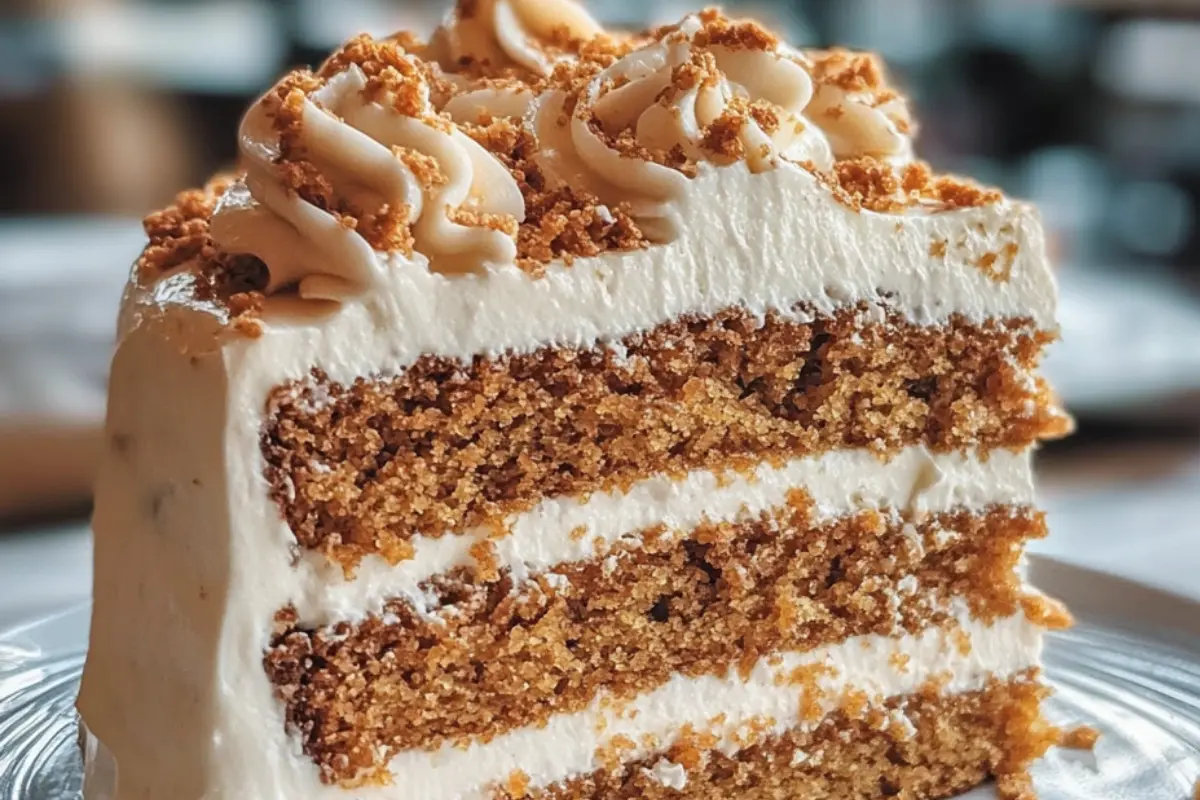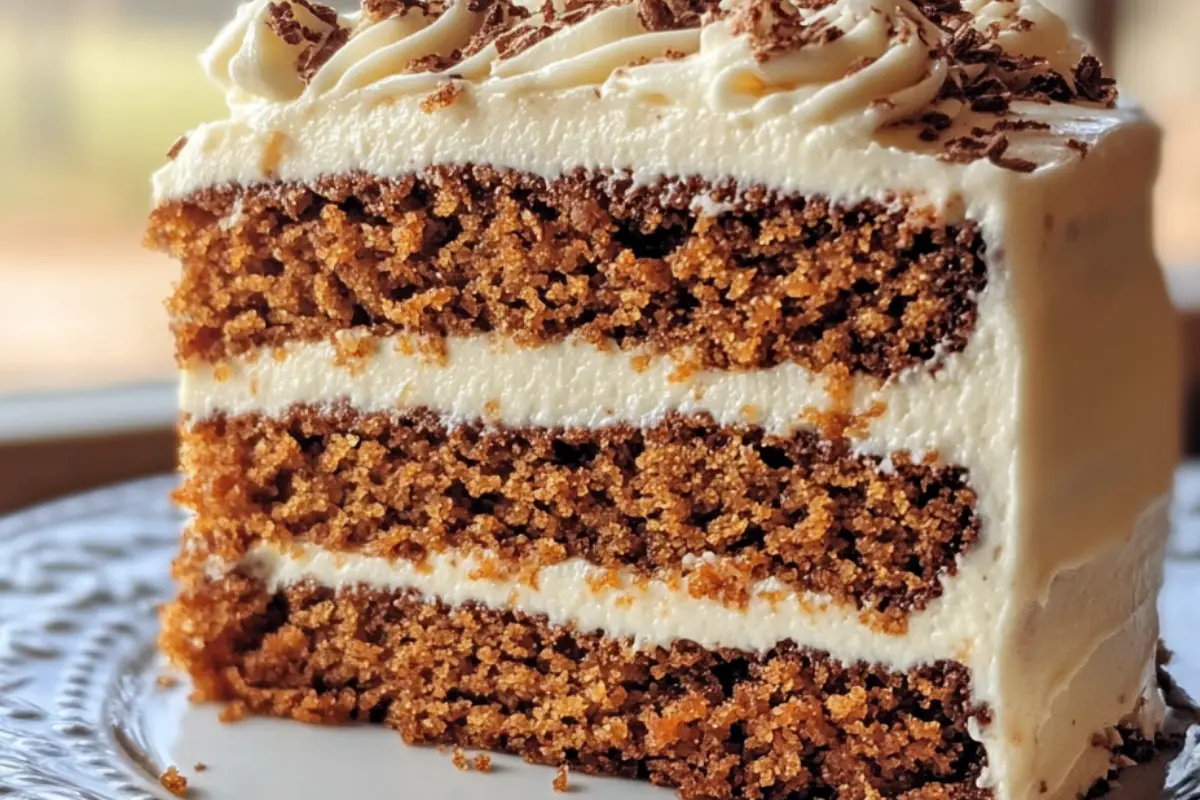Who doesn’t love a slice of moist, flavorful carrot cake? This timeless dessert is a favorite for many, combining the natural sweetness of carrots with warm spices and creamy frosting. Whether you’re a seasoned baker or just starting out, this recipe will guide you through making the perfect carrot cake. We’ll cover everything from ensuring your cake stays moist to offering nut-free alternatives and suggesting the best frosting to top it all off. Plus, we’ll even show you the right way to grate those carrots for the best texture.
Get ready to bake the best carrot cake of your life! Now, let’s dive into the ingredients and tools you’ll need.
Ingredients and Tools for Carrot Cake recipe
To create the perfect carrot cake, you’ll need to gather a few key ingredients and tools. The right combination of ingredients ensures that your cake turns out moist and flavorful, while the proper tools make the process easier and more efficient.
Essential Ingredients: The Perfect Carrot Cake recipe
Here’s what you’ll need for the cake batter:
- Carrots: Freshly grated carrots are the star of this recipe, providing natural sweetness and moisture.
- Flour: All-purpose flour works best, offering the right texture for a tender cake.
- Sugar: A mix of granulated and brown sugar adds depth of flavor.
- Eggs: These help bind the ingredients together, contributing to the cake’s structure.
- Oil: Vegetable or canola oil keeps the cake moist, even after a few days.
- Baking powder and baking soda: These leavening agents ensure your cake rises perfectly.
- Spices: Cinnamon, nutmeg, and a pinch of ginger for that classic warm flavor.
- Vanilla extract: Adds a hint of sweetness and aroma.
- Optional nuts: Walnuts or pecans add crunch, but can be omitted for a nut-free version.
Nut-Free Tip: If you’re avoiding nuts, simply leave them out without any substitutions. The cake will still be delicious and moist.
Recommended Tools
To make the baking process smoother, here are the tools you’ll need:
- Grater: For finely grating the carrots. A box grater works well, or you can use a food processor with a grating attachment.
- Mixing bowls: You’ll need a couple of bowls to mix the dry and wet ingredients separately.
- Whisk and spatula: A whisk to combine the ingredients and a spatula for folding everything together.
- Cake pans: Two 9-inch round cake pans or a 9×13-inch rectangular pan, depending on your preferred cake shape.
- Cooling rack: To cool the cakes evenly after baking.
Step-by-Step Recipe
Baking a carrot cake from scratch might seem daunting, but with the right steps, it’s quite simple. Follow these detailed instructions to ensure your cake turns out moist, flavorful, and perfectly baked.
Preparing the Carrots
The first step is to prepare the carrots, the most important ingredient in this recipe.
- Grate the carrots: Start by washing and peeling your carrots. Using a box grater, grate the carrots finely. If you prefer, you can use a food processor with a grating attachment to save time. Aim for about 2 cups of grated carrots.
- Tip for texture: Finely grated carrots will blend seamlessly into the cake, giving it a smooth texture and consistent moisture.
Mixing the Batter
Once your carrots are ready, it’s time to mix the batter.
- Combine the dry ingredients: In a large bowl, whisk together 2 cups of all-purpose flour, 1 ½ teaspoons of baking powder, 1 teaspoon of baking soda, 1 ½ teaspoons of ground cinnamon, ½ teaspoon of ground nutmeg, and ¼ teaspoon of ground ginger. These spices are crucial for that classic carrot cake flavor.
- Mix the wet ingredients: In a separate bowl, whisk together 1 cup of vegetable oil, 1 cup of granulated sugar, ½ cup of brown sugar, and 4 large eggs. Add 2 teaspoons of vanilla extract and mix until smooth.
- Combine wet and dry ingredients: Gradually add the dry ingredients to the wet mixture, stirring until just combined. Be careful not to overmix, as this can make the cake dense.
- Fold in the carrots and nuts: Gently fold in the grated carrots. If you’re using nuts, fold in 1 cup of chopped walnuts or pecans at this stage. The batter will be thick and rich.
Moisture Tip: The combination of oil, sugar, and finely grated carrots is what makes this cake so moist. Make sure to mix thoroughly to evenly distribute the moisture.
Baking the Cake
With your batter ready, it’s time to bake.
- Prepare the cake pans: Grease two 9-inch round cake pans or a 9×13-inch rectangular pan with butter or non-stick spray. Lightly flour the pans to prevent sticking.
- Divide the batter: If using round pans, divide the batter evenly between the two pans. For a rectangular pan, pour all the batter into the pan and spread it out evenly.
- Bake: Place the pans in an oven preheated to 350°F (175°C). Bake for 25-30 minutes if using round pans, or 35-40 minutes for a rectangular pan. The cake is done when a toothpick inserted into the center comes out clean.
- Cool: Allow the cakes to cool in the pans for 10 minutes before transferring them to a cooling rack. Let them cool completely before frosting.
Baking Tip: If the cake is browning too quickly on top, cover it loosely with aluminum foil for the last 10 minutes of baking.
Cooling and Frosting
Cooling the cake properly is key to achieving a perfect finish with your frosting.
- Cool completely: Make sure the cake is fully cooled before frosting. This prevents the frosting from melting and sliding off.
- Apply the frosting: Once cooled, frost the cake with your preferred frosting. We’ll cover the best options in the next section, but cream cheese frosting is a classic choice.
Frosting Options
The frosting is the finishing touch that brings the whole cake together. A classic choice is cream cheese frosting, but there are other delicious options if you want to mix things up. Let’s explore the best ways to top off your carrot cake.
 Cream Cheese Frosting
Cream Cheese Frosting
Cream cheese frosting is the quintessential pairing for carrot cake. Its tangy sweetness perfectly balances the warm spices in the cake.
- Ingredients:
- 8 oz (225g) cream cheese, softened
- ½ cup (115g) unsalted butter, softened
- 3-4 cups powdered sugar, sifted
- 1 teaspoon vanilla extract
- A pinch of salt
- Instructions:
- Beat the cream cheese and butter: In a large bowl, use a hand mixer or stand mixer to beat the softened cream cheese and butter together until smooth and creamy.
- Add the powdered sugar: Gradually add 3 cups of powdered sugar, 1 cup at a time, beating well after each addition. Add more sugar if you prefer a thicker frosting.
- Flavor it: Mix in 1 teaspoon of vanilla extract and a pinch of salt. Beat until the frosting is fluffy and smooth.
- Frost the cake: Once the cake is completely cooled, spread the frosting evenly over the top and sides. For a layer cake, add frosting between the layers before covering the entire cake.
Tip: For a touch of extra flavor, you can add a teaspoon of lemon juice or zest to the frosting for a slight tang.
Other Frosting Ideas
If you’re looking for something different, here are a few alternative frosting options that also pair beautifully with carrot cake:
- Whipped Cream Frosting: Light and airy, this frosting is less sweet and gives the cake a delicate finish. It’s ideal if you prefer something less rich than cream cheese frosting.
- Buttercream Frosting: Classic buttercream, made with butter, powdered sugar, and a touch of vanilla, offers a smooth, sweet complement to the spices in the cake.
- Coconut Frosting: For a tropical twist, consider a coconut-flavored frosting made with coconut cream and shredded coconut. It adds a light, fruity note to the cake.
Frosting Tip: If you’re making a nut-free cake, consider adding toasted coconut flakes on top of the frosting for some added texture and flavor.
Variations and Tips
One of the best things about a classic carrot cake is its versatility. Whether you’re catering to dietary preferences or looking to experiment with flavors, here are some ideas to help you tweak the recipe to your liking.
Nut-Free Carrot Cake
If you or your guests have a nut allergy, or if you simply prefer a nut-free cake, it’s easy to adapt this recipe.
- Omit the nuts: Simply leave out the chopped walnuts or pecans when mixing the batter. The cake will still be moist and flavorful without the crunch of nuts.
- Substitute with seeds: If you’d like to maintain some texture, consider adding seeds like sunflower or pumpkin seeds as a nut-free alternative. These add a subtle crunch without compromising the nut-free requirement.
- Other mix-ins: Dried fruit like raisins or chopped dried pineapple can be added for extra texture and flavor without using nuts.
Nut-Free Tip: Always check your ingredients, like flour and spices, to ensure they are processed in a nut-free facility if you’re serving someone with a severe nut allergy.
Adding Extra Flavors
While the classic carrot cake recipe is delicious on its own, there are plenty of ways to add extra flavor and texture to make it even more special.
- Pineapple: Crushed pineapple adds moisture and a subtle sweetness that pairs beautifully with the spices in the cake. Just be sure to drain the pineapple well to avoid adding too much liquid to the batter.
- Coconut: Shredded coconut can be mixed into the batter for a tropical twist. It adds both flavor and a bit of texture to each bite.
- Raisins: For a more traditional variation, add ½ cup of raisins to the batter. The natural sweetness of the raisins complements the spices and carrots perfectly.
Flavor Tip: If you’re adding wet ingredients like pineapple, reduce the amount of oil slightly to maintain the right batter consistency.
Storing and Serving
To ensure your carrot cake stays fresh and delicious, follow these tips for storing and serving:
- Storing: Carrot cake can be stored at room temperature for up to 2 days, as long as it’s covered well. For longer storage, keep the cake in the refrigerator for up to a week. If you’re using cream cheese frosting, refrigeration is recommended.
- Freezing: The cake freezes well, either frosted or unfrosted. Wrap the cake tightly in plastic wrap and then in aluminum foil before freezing. It can be stored in the freezer for up to 3 months. Thaw overnight in the refrigerator before serving.
- Serving: Serve the cake at room temperature for the best flavor and texture. If refrigerated, allow it to sit out for about 30 minutes before slicing.
Serving Tip: For an elegant presentation, garnish the cake with a dusting of powdered sugar, a few whole walnuts, or some finely grated carrot on top of the frosting.
FAQs
When it comes to baking the perfect carrot cake, a few questions tend to pop up frequently. Here are the answers to help ensure your cake turns out just right.
How do you make carrot cake moist?
Keeping a carrot cake moist is all about using the right ingredients and techniques.
- Use oil instead of butter: Oil provides more moisture than butter and keeps the cake tender even after a few days. Vegetable or canola oil works best.
- Don’t skimp on the carrots: The moisture from the grated carrots is essential. Make sure to use freshly grated carrots rather than pre-shredded ones, which can be drier.
- Mix ingredients carefully: Overmixing the batter can cause the cake to be dense rather than moist. Mix just until the ingredients are combined.
- Add pineapple: If you like, adding crushed pineapple to the batter can boost moisture levels without making the cake soggy. Just be sure to drain it well.
Can I make carrot cake without nuts?
Yes, you can easily make a nut-free carrot cake by simply leaving out the nuts.
- No substitutions needed: The cake will still be delicious without nuts. If you want to add some texture, consider using seeds like sunflower or pumpkin seeds.
- Ensure safety: If you’re serving someone with a nut allergy, double-check that all your other ingredients are nut-free, including any pre-packaged items.
What’s the best frosting for carrot cake?
Cream cheese frosting is the classic choice for carrot cake, offering a tangy contrast to the sweet, spiced cake.
- Cream cheese frosting: Made with softened cream cheese, butter, powdered sugar, and vanilla extract, this frosting is rich and creamy with just the right amount of sweetness.
- Other options: If you prefer a lighter topping, whipped cream frosting or buttercream frosting are also excellent choices. For a twist, try a coconut frosting for added flavor.
How do you grate carrots for carrot cake?
Grating carrots correctly is crucial for the texture of the cake.
- Use a fine grater: A box grater with a fine shredding side works well. You can also use a food processor with a grating attachment for quicker results.
- Grate just before using: Freshly grated carrots retain more moisture and flavor than pre-shredded ones, which can dry out in packaging.
- Avoid large chunks: Ensure the carrots are finely grated so they blend seamlessly into the batter, giving the cake a uniform texture.
Conclusion
There’s nothing quite like a homemade carrot cake—moist, flavorful, and topped with luscious cream cheese frosting. Whether you’re baking for a special occasion or just because, this recipe is sure to impress. With tips for making the cake nut-free, adding extra flavors, and choosing the best frosting, you can easily customize the cake to your liking.
Remember, the secret to a great carrot cake lies in the details: freshly grated carrots, the right amount of oil, and careful mixing. Follow the steps in this guide, and you’ll have a cake that’s not only delicious but also perfectly moist every time.
Now it’s your turn to give this recipe a try! What’s your favorite way to enjoy carrot cake? Do you have any unique twists or tips to share? Let us know in the comments below!



 Cream Cheese Frosting
Cream Cheese Frosting

